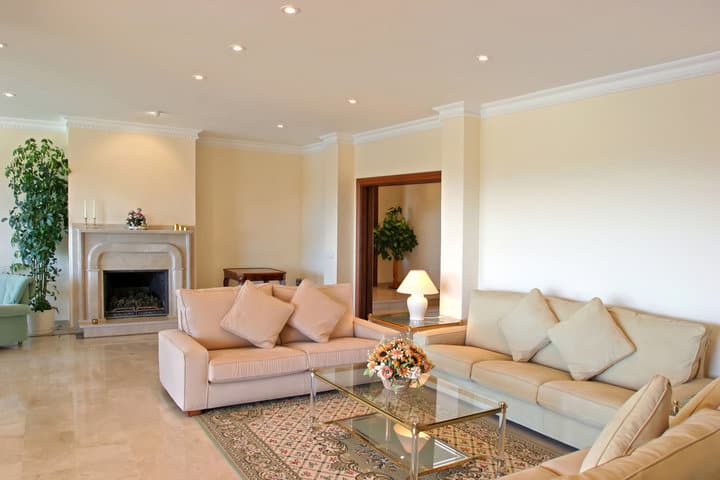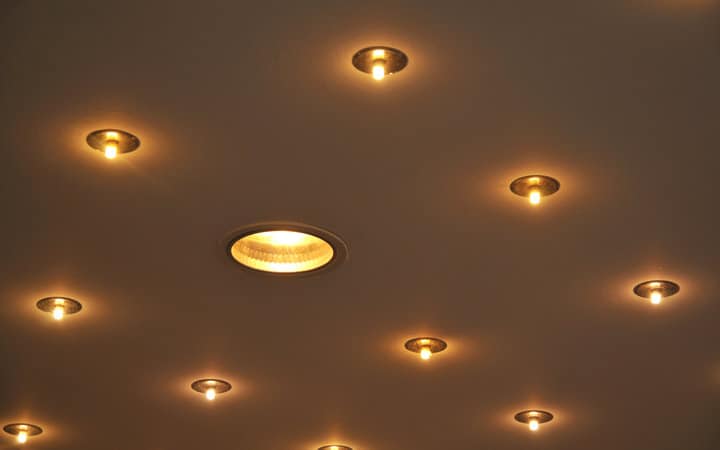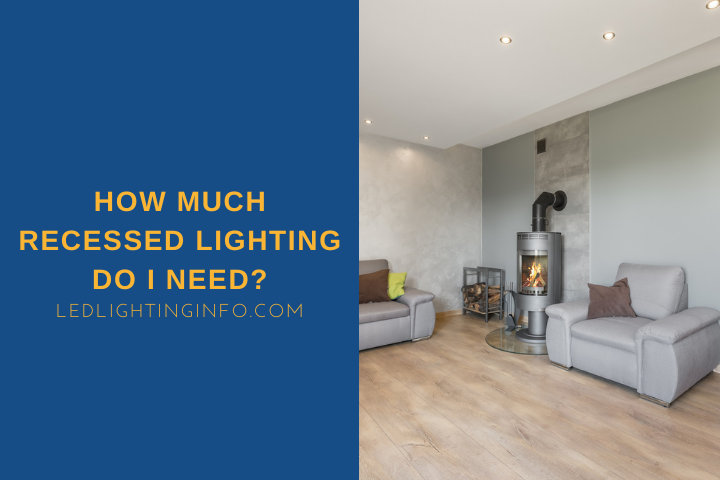Whether you’re redesigning a whole room from scratch or just considering a change of lighting, many are now opting to install recessed lights in their homes.
Compared to pendant lights, they offer a cleaner finish without necessarily sacrificing brightness, opening up the space in the room.
But how do you determine how many recessed lights you need for your room? And what factors will impact it?
You can calculate the recessed lights you need by multiplying the room’s square footage by 1.5 (1.7 for rooms needing brighter light) and then dividing by the wattage of lights used. If using LEDs, you need to divide by their equivalent wattage, not actual wattage.
It’s easier to explain with some examples, so let’s take a look at:
- How many recessed lights you need per square foot
- How to calculate the lighting spacing
- Whether you can have too many LED recessed lights
How Many Recessed Lights Do I Need Per Square Foot?

It’s not so much about how many lights you need per square foot – that makes it sound like you’ll have a lot of lights for every square foot, which would be overkill!
But instead, what you need to know is how to work out the correct number of lights to properly illuminate the room.
While this isn’t a scientifically measured method, it is widely accepted as the way to calculate the right amount of light.
You’ll want to work out the area of the room – not the volume, just the floorspace – so width is multiplied by length. And you need to do this in feet – it won’t work with meters.
You must multiply that by 1.5, giving you the total wattage of the light you need.
Then, divide that total wattage by the watts of the lights you want to use, and you have the correct number of lights.
Except, there are a couple of things to clarify here.
LED Lighting Wattage
Firstly, that formula doesn’t work for LED lights because those bulbs use a much lower wattage.
If you had a room that was 12 feet by 20 feet, that would be an area of 240 feet. Multiply that by 1.5, and you get 360 total watts required.
Divide that by 60 if you’re using 60-watt halogen bulbs, and you get 6 bulbs – a sensible amount.
Divide that by 8 if you’re using 8-watt LED bulbs and you get 45. That’s a lot of wiring and bulbs.
If you’re using LED lights, you need to read their equivalent wattage.
That’ll usually be advertised on the box or in the online product description.
Wouldn’t you know it – the equivalent wattage for an 8-watt LED bulb is usually 60 watts.
Brighter Rooms
As part of the formula above, you’re required to multiply the area of the room by 1.5 to get the total wattage you need.
But the flaw with the formula is that it applies the same level of light to every room.
You don’t want every room to have the same brightness – some rooms are more hazardous and should be brighter.
The kitchen and bathroom are the main two, but if you also have a workshop, then that’s another where you will want brighter lights.
For these rooms, you should use a multiplier of 1.7. This will give you extra wattage to ensure the room is bright enough.
Then you can use the same bulb wattage and have more or use a brighter bulb, which would mean dividing the total wattage by a higher number.
How Do I Calculate Recessed Lighting Spacing?
Once you know how many lights you need to illuminate your room, you can work out how to space your recessed lighting.
If you don’t do this step correctly, you could end up with a room that doesn’t have balanced lighting and looks pretty amateur.
Your lights might be recessed, but you’ll be able to tell if they aren’t spaced out properly – and it’ll always bug you.
To calculate the spacing, first, work out how many bulbs you need.
Then, you’ll want a light shape that matches the room.
You’ll want a rectangle of lights if it’s a typical rectangle. If the room is square, you’ll want a square formation.
And if the room is L-shaped, you’ll want to calculate two rectangles.
The lights should be spaced evenly. So if you have six lights in a rectangular room, you’ll want two rows of three.
Presuming you’re working with a rectangle, you’ll want to use the room dimensions to help you work out the spacing.
Divide the distance of the room (width or length) by the number of bulbs in a row.
So for the length of the room, say it was 18 feet. You will use six bulbs in total, in two rows of three. So you want to divide 18 by 3.
That gives you six feet, which is the distance between each bulb. The remaining six feet you split as the distance at the start and end of the row.
So, measure 3 feet from the wall – then mark for the first bulb. Then 6 feet between each bulb, leaving 3 feet between the last bulb and the far wall.
Do the same for the width. Again using the 12 feet example, divide that by 2 (2 bulbs across the width).
That gives you the answer 6 again, so measure 3 feet from the wall, mark the first bulb, then 6 feet between the two bulbs, then 3 feet from the last bulb to the wall.
So in summary:
- Divide the length of the room by the number of bulbs you’ll use lengthways. This gives you the space between bulbs – halve it for the distance from the wall to the first/last bulb
- Repeat for the width
Can I Have Too Many LED Recessed Lights?

You could have too many LED recessed lights, which could create problems if you aren’t careful.
Firstly, the room might be too bright. LEDs are bright bulbs, and the room will be very bright if you use too many.
This is potentially good for kitchens and bathrooms, but it might make rooms like your living room or bedroom less relaxing.
They’re never going to be blinding – light doesn’t accumulate that way – but you might not want a super-bright space where you want to unwind.
If you mess up and install too many lights, then you could just add a dimmer.
The other concern with adding too many lights is your energy costs. Even with LED lights, you don’t want to waste money on lights you don’t need.
Say a room only needed 6 recessed lights to be properly lit, but you’d installed 10. So if you use 8-watt bulbs, that’s 32 watts of power you’re using that isn’t necessary.
If you use the lights for 5 hours daily, that’s an excess of 160-watt hours or 0.16-kilowatt hours.
Over a year, that’s 58.4 wasted kilowatt-hours – if your electricity costs $0.11 per kilowatt hour then you’ve wasted $6.42 that year.
But you’ve also wasted the cost of the extra bulbs.
It may not seem like huge sums, but it’ll add up over the bulbs’ lifetime.
So make sure you do the calculations right and only install the number of lights you need.
Also read: How To Run Wire For Recessed Lights?
Final Words
I think something in the name ‘recessed lights’ makes people think they aren’t as bright as other lights because they’re hidden in a recess?
But that doesn’t mean you need to overcompensate.
Follow the tried and tested formulae and you can get just the right amount to illuminate your room to the desired level, without wasting time and electricity.
Plus – the fewer you need, the less work you have to do to install them in the first place!
Have you installed new recessed lighting in your home?
Did you follow these formulae, or did you use another method?
Looking for an LED bulb but not sure what type you need?
Check out my free bulb picker and select the right bulb within few clicks.


